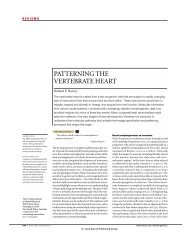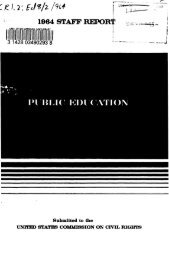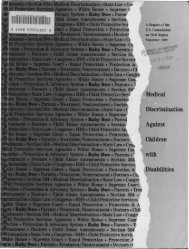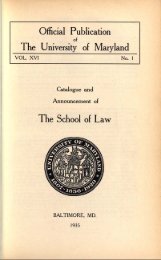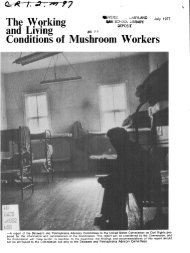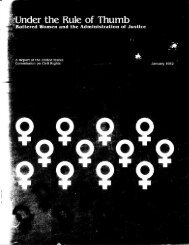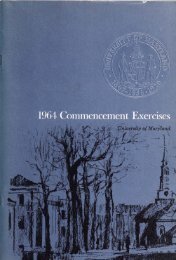tion for <strong>the</strong> Peabody evaluation (see note 2) andstated, "Several major components of this plan relateto <strong>the</strong> Peabody Study."The plan calls for grade reorganization, <strong>the</strong> clos<strong>in</strong>gof some schools and <strong>the</strong> construction of newfacilities, pupil reassignments, and o<strong>the</strong>r actions tomeet <strong>the</strong> objectives. Specifically, <strong>the</strong> plan calls forclos<strong>in</strong>g six elementary schools, five of which are <strong>in</strong><strong>the</strong> central city and four of which have m<strong>in</strong>orityenrollments of 75 percent or more. Thus 4 of <strong>the</strong>10 elementary schools with predom<strong>in</strong>antly m<strong>in</strong>orityenrollments would be closed. Two of <strong>the</strong> elementaryschools to be closed under this proposalwould be turned <strong>in</strong>to enrichment centers wherefourth- and fifth-grade students would spend 1week each semester for human relations tra<strong>in</strong><strong>in</strong>gand preparation for later school years. Elementaryschools would conta<strong>in</strong> grades K-5, junior highschools would house grades 6-8, and senior highschools would serve grades 9-12. Students currentlyattend<strong>in</strong>g schools that would be elim<strong>in</strong>ated<strong>in</strong> <strong>the</strong> plan would be transferred to schools immediatelyborder<strong>in</strong>g <strong>the</strong> central city. F<strong>in</strong>ally, a newhigh school would be built <strong>in</strong> <strong>the</strong> predom<strong>in</strong>antlywhite, nor<strong>the</strong>astern portion of <strong>the</strong> school district.Grile's proposals have not met with unanimousapproval among board members, and muchsharper criticism has been directed aga<strong>in</strong>st <strong>the</strong>plan by o<strong>the</strong>r members of <strong>the</strong> community. Boardmember Lorra<strong>in</strong>e Davis stated, "I want toemphasize this is a proposed plan. As far as <strong>the</strong>adm<strong>in</strong>istration is concerned this may be a s<strong>in</strong>gleunit plan, but as far as <strong>the</strong> community is concerned,and perhaps as far as <strong>the</strong> board is concernedit's not necessarily a unit plan." 18 FredMeriwe<strong>the</strong>r, one of two black board members said,"I'm not pleased with <strong>the</strong> plan as it presently exists.The comment I hear over and over aga<strong>in</strong> isthat it seems as if <strong>the</strong> onus is be<strong>in</strong>g put on <strong>the</strong>m<strong>in</strong>ority community aga<strong>in</strong>." 19 Board memberLeonard Goldste<strong>in</strong> claimed <strong>the</strong> commitment madeby <strong>the</strong> board on July 8, 1974, "to elim<strong>in</strong>ate racialsegregation <strong>in</strong> <strong>the</strong> entire school system," is diluted<strong>in</strong> <strong>the</strong> plan. However, Goldste<strong>in</strong> said he found <strong>the</strong>plan "acceptable, but fall<strong>in</strong>g far short of what Ith<strong>in</strong>k is even a beg<strong>in</strong>n<strong>in</strong>g of what we want." 20The major criticism of <strong>the</strong> plan from o<strong>the</strong>r communitymembers revolves around <strong>the</strong> desegregationissue. It is reportedly argued, first, that <strong>the</strong>plan does not go far enough towards desegregat<strong>in</strong>g<strong>the</strong> schools and, secondly, that <strong>the</strong> burden isplaced entirely on <strong>the</strong> black community. Somecritics ma<strong>in</strong>ta<strong>in</strong> that <strong>the</strong> extent of desegregationpredicted <strong>in</strong> <strong>the</strong> plan is less than that <strong>in</strong> any of <strong>the</strong>five plans recommended <strong>in</strong> <strong>the</strong> Peabody report. 21Former Mayor Ivan Lebamoff charged <strong>the</strong> planwas designed to barely meet legal pressures fordesegregation. 22 Grile's response to this l<strong>in</strong>e of argumentwas that <strong>the</strong> Peabody plans would notcompletely desegregate all <strong>the</strong> schools and that hisplan would result <strong>in</strong> 66 percent of all black studentsattend<strong>in</strong>g schools with a white majority andjust 33 percent attend<strong>in</strong>g majority black schools by1980. In addition, only 6 of <strong>the</strong> 38 elementaryschools would be predom<strong>in</strong>antly black by thattime. 23Nowhere <strong>in</strong> <strong>the</strong> plan or <strong>in</strong> <strong>the</strong> newspaper articlesobta<strong>in</strong>ed by <strong>the</strong> Midwest Regional Office of <strong>the</strong>U.S. Commission on Civil Rights, however, doesGrile make any reference to <strong>the</strong> 10 percent to 30percent band cited <strong>in</strong> <strong>the</strong> Peabody report asprovid<strong>in</strong>g "optimum potential for mean<strong>in</strong>gfulm<strong>in</strong>ority-majority <strong>in</strong>teraction." One question thatrema<strong>in</strong>s unanswered is what percentage of <strong>the</strong>schools will be brought with<strong>in</strong> this band. Grilestated his plan would reduce <strong>the</strong> percentage ofblack students attend<strong>in</strong>g majority black schools to33 percent. This would represent a reduction ofapproximately 10 percent, s<strong>in</strong>ce 43 percent ofm<strong>in</strong>ority students were enrolled <strong>in</strong> predom<strong>in</strong>antlym<strong>in</strong>ority schools <strong>in</strong> 1975 (see table 1). As <strong>in</strong>dicatedabove, this is not considered enough bysome board members and o<strong>the</strong>rs <strong>in</strong> <strong>the</strong> communi-ty-Harsher comments were directed at <strong>the</strong> planbecause it places <strong>the</strong> burden of desegregation on<strong>the</strong> black community. The fact that all bus<strong>in</strong>gwould be one way, <strong>in</strong>volv<strong>in</strong>g bus<strong>in</strong>g of black studentsout of <strong>the</strong> central city, and that a new highschool would be built <strong>in</strong> a predom<strong>in</strong>antly whitearea while several schools <strong>in</strong> <strong>the</strong> central city wouldbe closed were particularly sore po<strong>in</strong>ts. One blackmo<strong>the</strong>r said, "We have been go<strong>in</strong>g to <strong>the</strong> whiteschools for a long time. It's time for you to cometo some of our schools." She went on to arguethat it would be just as easy to remodel <strong>the</strong> olderschools as to tear <strong>the</strong>m down. 24 Concerns werealso expressed about decl<strong>in</strong><strong>in</strong>g property values <strong>in</strong><strong>the</strong> central city once <strong>the</strong> schools were gone and<strong>the</strong> difficulty parents would have <strong>in</strong> gett<strong>in</strong>g to PTA6
meet<strong>in</strong>gs and hav<strong>in</strong>g a role <strong>in</strong> <strong>the</strong> school community<strong>in</strong> general. 25 In respond<strong>in</strong>g to questions about<strong>the</strong> possibility of two-way bus<strong>in</strong>g and build<strong>in</strong>g <strong>the</strong>high school <strong>in</strong> <strong>the</strong> central city, Grile said <strong>the</strong> adm<strong>in</strong>istrationdoes not th<strong>in</strong>k "two-way bus<strong>in</strong>g hasan educational value. We do not th<strong>in</strong>k it is worth<strong>the</strong> effort or <strong>the</strong> money." He argued that by construct<strong>in</strong>g<strong>the</strong> new high school where <strong>the</strong> populationis grow<strong>in</strong>g most rapidly, fewer students willhave to be bused than if it were built <strong>in</strong> <strong>the</strong> centralcity. 26But <strong>the</strong>se are not <strong>the</strong> only issues. Grile was alsocriticized by Frank W. Heyman, executive directorof <strong>the</strong> Allen County Economic <strong>Opportunity</strong> Council(ACEOC), for "<strong>the</strong> arrogance with which thisplan was put forward." In response to Grile's claimthat <strong>the</strong> plan should be treated as a total package,Heyman went on to say, "No plan is such a sacredcow that any piece of it can't be discussed by <strong>the</strong>community." 27 Lebamoff also accused Grile of fail<strong>in</strong>gto take <strong>in</strong>to consideration any <strong>in</strong>put from <strong>the</strong>community: "We've broken our backs, given <strong>the</strong>school adm<strong>in</strong>istration some real honest to goodnessth<strong>in</strong>k<strong>in</strong>g over which we agonized, yet we'vehad absolutely no response, or even any <strong>in</strong>dication<strong>the</strong>y wanted to listen." He went on to say,"They've rejected our suggestions out of hand;<strong>the</strong>y've rejected <strong>the</strong> Urban League's suggestions;<strong>the</strong>y've rejected <strong>the</strong> <strong>Fort</strong> <strong>Wayne</strong> Education Association'ssuggestions." 28 Rose Gerra, a representativeof <strong>the</strong> Educational Council for Lat<strong>in</strong>o Affairs,noted that <strong>the</strong> plan failed to <strong>in</strong>clude anyprovision aimed at fur<strong>the</strong>r<strong>in</strong>g bil<strong>in</strong>gual and biculturaleducation, 29 an issue also covered <strong>in</strong> <strong>the</strong> IndianaCivil Rights Commission's compla<strong>in</strong>t.One <strong>in</strong>dication of <strong>the</strong> reaction to Grile's plan <strong>in</strong><strong>the</strong> black community is a petition, signed by 1,500parents, oppos<strong>in</strong>g <strong>the</strong> plan. The petition criticizes<strong>the</strong> plan for its reliance on one-way bus<strong>in</strong>g, for <strong>the</strong>proposal to build a new high school on <strong>the</strong> northside of <strong>the</strong> district, and for "dodg<strong>in</strong>g <strong>the</strong> issue" ofdesegregation of grades K-5. 30 Several o<strong>the</strong>r organizations,<strong>in</strong>clud<strong>in</strong>g <strong>the</strong> <strong>Fort</strong> <strong>Wayne</strong> UrbanLeague, <strong>the</strong> <strong>Fort</strong> <strong>Wayne</strong> NAACP, <strong>the</strong> <strong>Fort</strong> <strong>Wayne</strong>Education Association, and <strong>the</strong> Allen CountyEconomic <strong>Opportunity</strong> Council have all madepublic statements aga<strong>in</strong>st <strong>the</strong> plan. One possibletactic that has been discussed is to draw up an alternativeplan to present to <strong>the</strong> board. 31An Alternative to <strong>the</strong>Super<strong>in</strong>tendent's ProposalA coalition of organizations—<strong>in</strong>clud<strong>in</strong>g <strong>the</strong>ACEOC, <strong>the</strong> <strong>Fort</strong> <strong>Wayne</strong> Urban League, <strong>the</strong> <strong>Fort</strong><strong>Wayne</strong> NAACP, and several o<strong>the</strong>r organizationsand <strong>in</strong>dividuals—has been organized and is consider<strong>in</strong>g<strong>the</strong> possibility of present<strong>in</strong>g an alternativeplan to <strong>the</strong> board. (See appendix E for a list ofcoalition organization members.) At least onecoalition member, <strong>the</strong> <strong>Fort</strong> <strong>Wayne</strong> Urban League,has presented detailed alternatives to segments ofGrile's proposal. (See appendix F for <strong>the</strong> UrbanLeague's response.) Reverend Clyde Adams, oneof <strong>the</strong> petition drive leaders, has exhorted variousgroups to organize: "Any impact this community isgo<strong>in</strong>g to make—we've got to make it now andwe've got to make it toge<strong>the</strong>r***. No public servantis immune from public pressure***. Onceyou get an organization that's really organized,you're go<strong>in</strong>g to get heard." 32Charles Redd, a member of <strong>the</strong> Indiana AdvisoryCommittee, told Commission staff he would like<strong>the</strong> board to at least postpone its vote <strong>in</strong> order togive <strong>the</strong> coalition time to present its plan. Two relatedproblems, accord<strong>in</strong>g to Redd, are locat<strong>in</strong>g<strong>the</strong> technical assistance required to draw up a planand <strong>the</strong> f<strong>in</strong>ancial resources to support <strong>the</strong> work.Even if this meant a 1-year delay <strong>in</strong> implementationof a desegregation plan, Redd believes <strong>the</strong>greater payoff would make <strong>the</strong> wait worthwhile.Notes to Chapter One1. U.S., Commission on Civil Rights, To Ensure <strong>Equal</strong> Educational<strong>Opportunity</strong> (1975), pp. 360 and 386.2. In January 1975 <strong>the</strong> board of trustees and <strong>the</strong> super<strong>in</strong>tendentof <strong>the</strong> <strong>Fort</strong> <strong>Wayne</strong> <strong>Community</strong> <strong>Schools</strong> authorized <strong>the</strong> Officeof Educational Services of George Peabody College forTeachers to make a comprehensive study of <strong>the</strong> school corporation.In its report, <strong>Fort</strong> <strong>Wayne</strong> <strong>Community</strong> <strong>Schools</strong> (1975),<strong>the</strong> Peabody consultants suggested <strong>the</strong> 10 percent to 30 percentband as an ideal because it "offers <strong>the</strong> optimum potential formean<strong>in</strong>gful m<strong>in</strong>ority-majority <strong>in</strong>teraction without precipitouswhite flight." (p. 246) However, <strong>in</strong> <strong>the</strong> five desegregation plansrecommended to <strong>the</strong> school system <strong>in</strong> <strong>the</strong> Peabody report, nonewould br<strong>in</strong>g all <strong>the</strong> elementary schools with<strong>in</strong> this band becauseto do so "would require large-scale bus<strong>in</strong>g, across distances upto eight miles, and forego most prospects for preserv<strong>in</strong>gneighborhood schools for any of <strong>the</strong> lower grades." (p. 256) Infact none of <strong>the</strong> plans would br<strong>in</strong>g more than 70 percent of <strong>the</strong>elementary schools with<strong>in</strong> this band. (p. 277)The Peabody report noted that as of <strong>the</strong> 1974-75 school yearall junior and senior high schools were with<strong>in</strong> <strong>the</strong> 10-30 percentband. (p. 277) It should also be noted that as of <strong>the</strong> fallof 1975 two of <strong>the</strong> schools fell outside this band, one with a7




